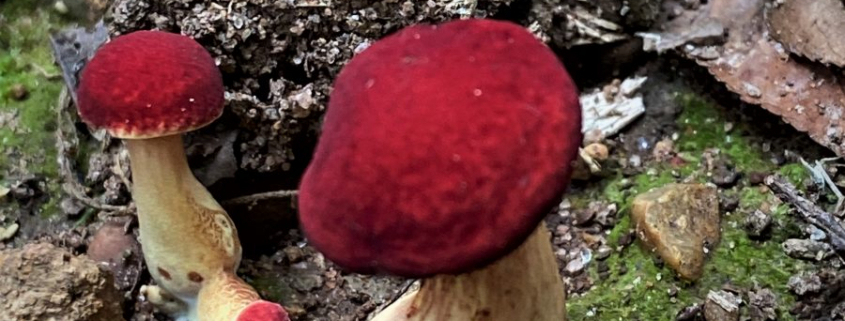Fungi Reign along Joe Wheeler State Park’s New “Awesome Trail”
See the Great Blue Heron Post chronicling my June 8, 2020 introduction to the new Awesome Trail at Joe Wheeler State Park: https://stevejonesgbh.com/2020/07/06/joe-wheeler-state-parks-new-awesome-trail/
That single Post was not sufficient to chronicle all the Nature-magic we encountered. We also saw some spectacular mushrooms as we hiked our four-mile segment, justifying this second Post highlighting the fungi.
The Fungi Kingdom — Ruling the Forest
I’ve admitted often that I am a novice-at-best when it comes to our ubiquitous forest fungi inhabitants. While it’s the trees my education directed me to see, understand, and admire, I have long known that no living creature exists in isolation. The trees would amount to nothing were it not for their co-dependent mycorrhizae, fungi that grow symbiotically on and within tree root hairs aiding by orders of magnitude the absorption of soil moisture and nutrients, and in turn feed on carbohydrates produced by the tree. Many species of fungi act as primary agents of decay, returning dead and down woody debris to the soil, and thence to subsequent life. And some species act as tree pathogens. No wonder fungi stand as an Earth-life kingdom unto themselves.
Because I am in the early stages of my quest to learn more about our woodland fungal neighbors here in north Alabama, please view this Post as an exploration… not as a definitive recitation of genus and species. Most of the names (common and scientific) come with less than full confidence from iNaturalist. Please view this Post as a catalog of photographs and a celebration of the diverse, colorful, and mysterious collection of mushrooms we encountered on an early summer four-mile hike through the 80-90-year-old forest.
Riches on the Forest Floor
Green dominates our June forests, from understory through main canopy. For that reason, I train my eyes to seek other-than-green. These yellow patches mushrooms (Amanita flavoconia) vividly proclaimed their presence. Tiny in comparison to the mighty oaks, these two stand at about three inches, yet they act as visual beacons. Funny that once I see one, my eye imprints, and others suddenly appear. From MushroomExpert.com: This beautiful mushroom is one of the most common species of Amanita in the Midwest and in eastern North America, where it usually begins to appear in early and mid-summer. Yellow patches is a micorrhizal fungi, common in oak forests throughout our region.
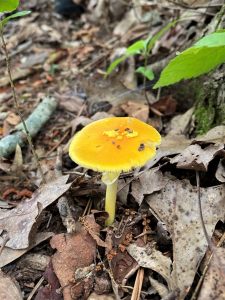
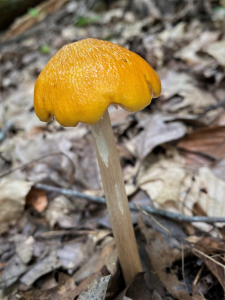
Tremellodendron Wikipedia: Tremellodendron is a genus of fungi in the family Sebacinaceae. Its species are mycorrhizal, forming a range of associations with trees and other plants. Basidiocarps are produced on soil and litter. The fruit bodies are clavarioid and leathery to rubbery-gelatinous. The genus is restricted to the Americas. Regardless of whether my identification is correct, this individual strikes me as very coral-like. Just inches away is what I can identify with certainty as an LBM (little brown mushroom)!
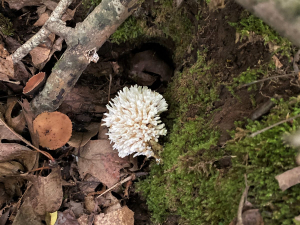
Again, had we been rushing from boat launch to marina, we likely would have missed the splashes of red on an old stump (below left) and a long-fallen log (below right). May I introduce you to red raspberry slime mold (Tubifera ferruginosa)? Because we were nearing the noon hour, I contemplated a red raspberry slime mold smoothie and a peanut butter and red raspberry slime mold sandwich. I don’t recall ever seeing this delightful fungus before now. I discern from the advanced state of decay of both the stump and the log that this fungus prefers that others perform the primary work of early decomposers.
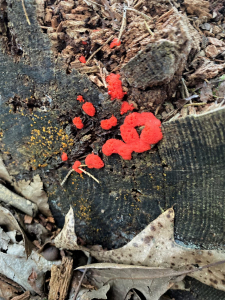
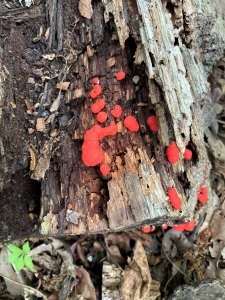
From red raspberry to green cheese polypore (Fomitopsis spraguei). Were this one edible (I don’t know for sure that it’s not), this red oak basal mushroom would have been a full meal. Unlike the red raspberry slime mold (a saprophyte), this fungus is parasitic.
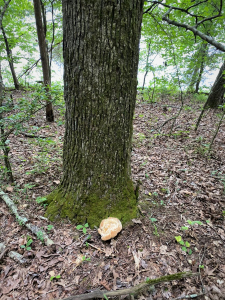
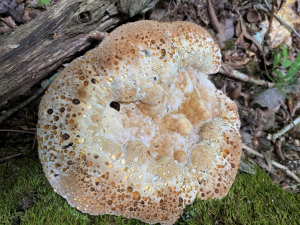
Reading the Forested Landscape
We came across this wind-toppled red oak and its outer-ring polypore (Trametes sp.) growing on the exposed face where the crew had cut to bring the levered, elevated top to ground level, a trail-user safety measure. Interesting that the outer annual rings, the more recently functioning xylem and phloem, would appear to be more attractive to early-stage saprophytes. Of course, eventually fungi will inhabit and consume the entire log.
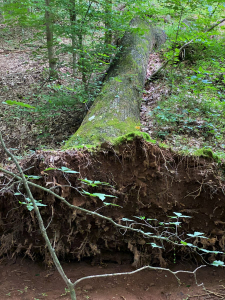
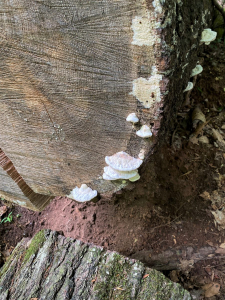
The sawed-through downed oak revealed a fact we had pondered since we entered the trail — how old is this forest along the Wheeler-dammed Tennessee river? I rough-counted the exposed rings, arriving at 80-90 years. I would have needed sand paper and a hand lens to be more precise. Dam construction extended from 1933 to 1936. Crews would also have been clearing the designated (and TVA-bought) inundation acreage during that period. TVA had also purchased (eminent domain) the adjoining 2,550 acres that the state acquired from TVA in 1949, and dedicated to Joe Wheeler State Park. Production agriculture likely ceased on the imminent Park land by 1935, 85 years ago. The naturally regenerated forest we traversed, therefore, would now be 80-90 years old. I enjoy forest sleuthing! Every tree…every stand…every forest…every State Park has a story to tell. A Land Legacy Story wherein human and natural history inter-weave.
I have often observed that all once-living tissue is edible by something else in every Earth ecosystem. Trametes aesculi (top view and bottom, respectively, left and right below) mycelia are performing their duty on a downed oak branch. The elegant dance of life and death!
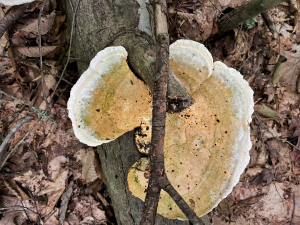
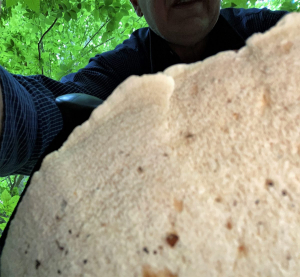
I have found the quite common false turkey tail (Trametes cubensis) across north Alabama. In fact, I can say that they are everywhere I trek.
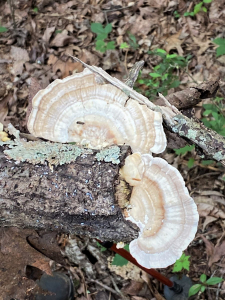
I heard for months that our June would bring an abundance of chanterelle mushrooms… delectable, easy to identify, and simple to harvest and prepare. However, I have found little more than none. We did find a handful of smooth chanterelles (Chanterllis lateritius), but not enough to collect, even if we had not been on a State Park, where collecting is prohibited.
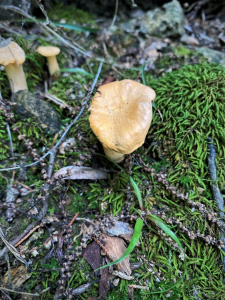
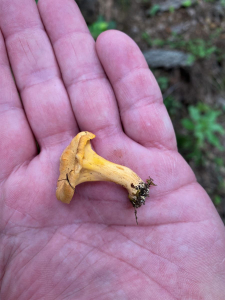
Stories Aplenty
As a forester bearing down on his 69th birthday, I had mixed feelings about discovering an old man of the woods (Strombilomyces floccopus)! I suppose it takes one to know one. Wikipedia offers a brief description:
Old man of the woods, is a species of fungus in the family Boletaceae. It is native to Europe and North America. Fruit bodies are characterized by very soft dark grey to black pyramidal and overlapping scales on the cap surface.
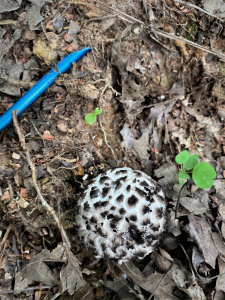
MushroomExpert.com offers a more entertaining explanation:
“. . . for the satirical rogue says here that old men have grey beards, that their faces are wrinkled, their eyes purging thick amber or plum-tree gum, and that they have a plentiful lack of wit, together with weak hams . . .”
This is Hamlet’s description of his girlfriend’s father, Strobilomyces polonius, but it works reasonably well for the “Old Man of the Woods” as well.
How this mushroom got its oddly appropriate common name is unclear to me. I can find no one using it in turn-of-the-century mushroom treatises, or in the first half of (what has just become) the last century. The scientific name, Strobilomyces floccopus, roughly translated, means “woolly mushroom that looks like a pine cone”–rather more accurate as a descriptor, perhaps, but less interesting. As late as 1936, mushroom authors are using interpretations of the scientific name as “common” names; Krieger calls it the “cone-like boletus” in The Mushroom Handbook, and William Thomas calls it the “pine cone mushroom” in Field Book of Common Mushrooms. The first reference to the “Old Man of the Woods” I have seen is in the 1963 edition of Smith’s The Mushroom Hunter’s Field Guide.
I remind you, every element of Nature has a story, including old man of the woods.
These little beauties could not be better named, for they do indeed resemble a collection of helmeted soldiers. They are trooping crumble caps (Coprinellus disseminatus). The moniker crumble caps owes to their tendency to disintegrate when touched. Ah, the incredible diversity of form, function, and appearance of living organisms within the fungi kingdom. Who could have anticipated the extraordinary range we discovered along a four-mile hike through an 80-90-year-old forest.
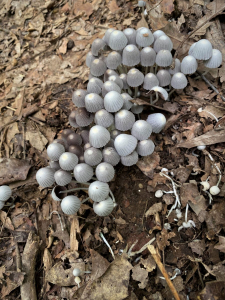
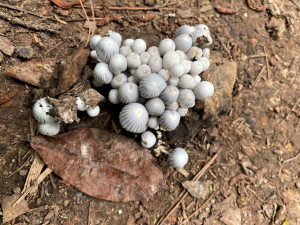
We found several small groupings of black trumpet (Craterellus fallax), a curious species Mushroom Expert.com described as:
Common and easily recognized–but hard to discover. The mushrooms are small and black, and something about their shape and fruiting pattern can make them extremely difficult to see. The vase-shaped fruiting bodies have finely scaly, gray to black upper surfaces and smooth or very shallowly wrinkled outer surfaces that are initially blackish but develop yellowish to orangish shades as the spores mature.
The great thing about the black trumpet is that any of us, given the chance, would have named these mushrooms “black trumpet”! They look like their name, pure and simple. I learned doing research for this Post that mushroom enthusiasts consider these beauties as superb culinary delicacies! From this day forward I shall imprint their image deep within my optical cortex, urging me to be ever alert through our long growing season. I’m eager to collect and simmer a few in butter, olive oil, and seasoning salt!
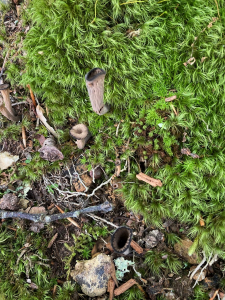
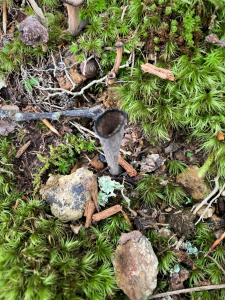
Once again, I think of Seuss, Tolkien, and Lewis Carroll — the magic world of black forest trumpets, trooping crumble caps, and old men of the woods!
From First Nature online: Peeling oysterling (Crepidotus mollis) is also referred to in some field guides as the Soft Slipper Mushroom; it is a rubbery, fan-shaped fungus that grows on the trunks, large branches and stumps of dead broad-leaf trees.
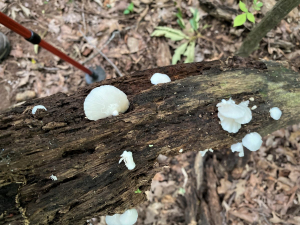
Fungal Identity Crises
Ruby bolete (Hortiboletus rubellus) surfaces as the preferred iNaturalist identity for this truly spectacular mushroom. However, none of the reference sites or photos seem to fit the image I recorded. I will leave it as ruby bolete, even as I will query applicable Facebook groups for verification. What a shame to not be certain of the identity for what I consider our best find of the day in terms of beauty, intrigue, and uniqueness.
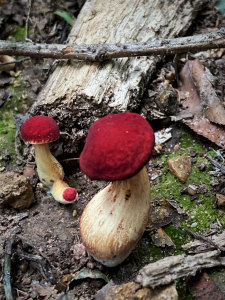
And, sad to say, iNaturalist also calls this companion find a ruby bolete (Boletus sp.). I shall remain stymied for the moment.
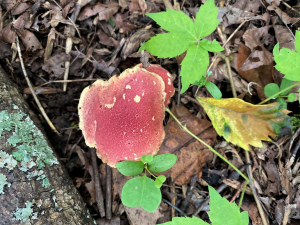
I started this Post with yellow patches mushrooms (Amanita flavoconia). Have I come full circle, or is this something different? I have confidence that this is a member of the Amanita genus, but neither I nor iNaturalist confirms a species. I suppose it is fitting that I end the Post with a bit of identity spinning and confusion. Suffice it to say that we encountered a full palette of mushroom colors, forms, and functions.
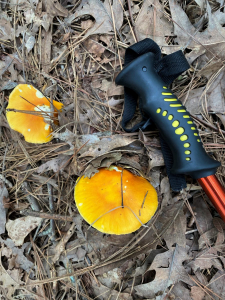
So, rather than end with uncertainty, I’ll close with a simple white bracket fungi. This time I turn to Wikipedia: Ganoderma megaloma is a species of bracket fungus in the family Ganodermataceae. Described as new to science in 1846 by mycologist Joseph-Henri Léveillé, it is found in the eastern and Midwestern United States. My iNaturalist app declared the identity without hesitation.

What a joyful day as amateur (novice) mycologists chronicling the mushrooms we encountered with photographs and less than reliable identification. I do have a strong desire to learn more, matched by powerful curiosity and absolute admiration for the complex roles of fungi in our north Alabama forest ecosystems.
Thoughts and Reflections
I draw two simple truths from diving into the forest fungal kingdom at Joe Wheeler State Park:
Wonder awaits those exploring our forests with an eye to the ground and an insatiable hunger to learn.
The forest is a complex interconnected and continuous cycle of life, death, and diversity.
Inhale and absorb Nature’s elixir. May Nature Inspire, Inform, and Reward you!
Note: All blog post images created & photographed by Stephen B. Jones unless otherwise noted. Please circulate images with photo credit: “©2020 Steve Jones, Great Blue Heron LLC. All Rights Reserved.”
Another Note: If you came to this post via a Facebook posting or by an another route, please sign up now (no cost… no obligation) to receive my Blog Post email alerts: http://eepurl.com/cKLJdL
And a Third: I am available for Nature-Inspired Speaking, Writing, and Consulting — contact me at steve.jones.0524@gmail.com
Reminder of my Personal and Professional Purpose, Passion, and Cause
If only more of us viewed our precious environment through the filters I employ. If only my mission and vision could be multiplied untold orders of magnitude:
Mission: Employ writing and speaking to educate, inspire, and enable readers and listeners to understand, appreciate, and enjoy Nature… and accept and practice Earth Stewardship.
Vision:
- People of all ages will pay greater attention to and engage more regularly with Nature… and will accept and practice informed and responsible Earth Stewardship.
- They will see their relationship to our natural world with new eyes… and will understand more clearly their Earth home.
Tagline/Motto: Steve (Great Blue Heron) encourages and seeks a better tomorrow through Nature-Inspired Living!
Steve’s Three Books
I wrote my books Nature Based Leadership (2016), Nature-Inspired Learning and Leading (2017), and Weaned Seals and Snowy Summits: Stories of Passion for Place and Everyday Nature (2019; co-authored with Dr. Jennifer Wilhoit) to encourage all citizens to recognize and appreciate that every lesson for living, learning, serving, and leading is either written indelibly in or is powerfully inspired by Nature.
I began writing books and Posts for several reasons:
- I love hiking and exploring in Nature
- I see images I want to (and do) capture with my trusty iPhone camera
- I enjoy explaining those images — an educator at heart
- I don’t play golf!
- I actually do love writing — it’s the hobby I never needed when my career consumed me
- Judy suggested my writing is in large measure my legacy to our two kids, our five grand kids, and all the unborn generations beyond
- And finally, perhaps my books and Blogs could reach beyond family and touch a few other lives… sow some seeds for the future


All three of my books (Nature Based Leadership; Nature-Inspired Learning and Leading; Weaned Seals and Snowy Summits) present compilations of personal experiences expressing my (and co-author Dr. Wilhoit for Weaned Seals and Snowy Summits) deep passion for Nature. All three books offer observations and reflections on my relationship to the natural world… and the broader implications for society. Order any and all from your local indie bookstore, or find them on IndieBound or other online sources such as Amazon and LifeRich.

